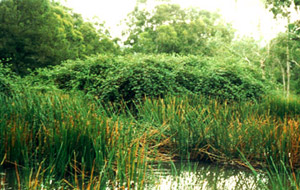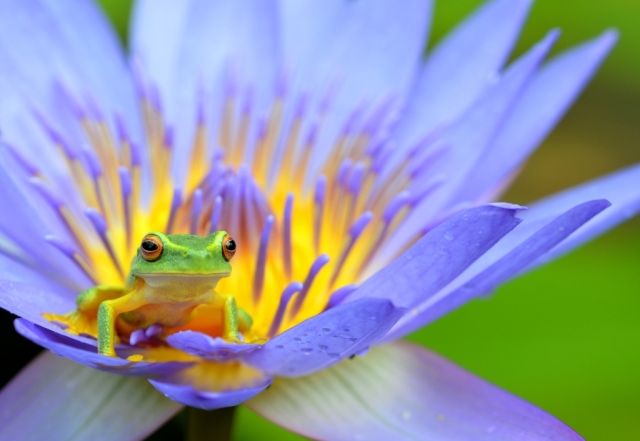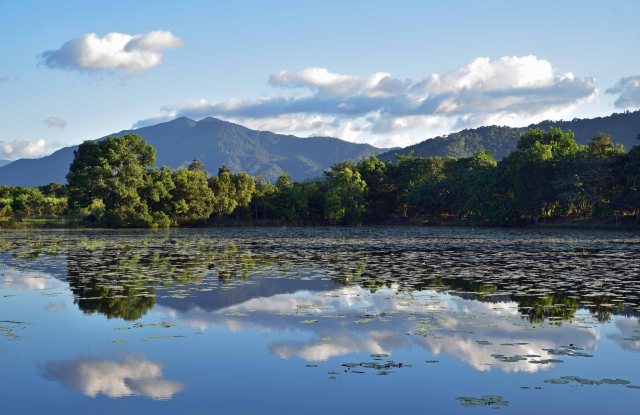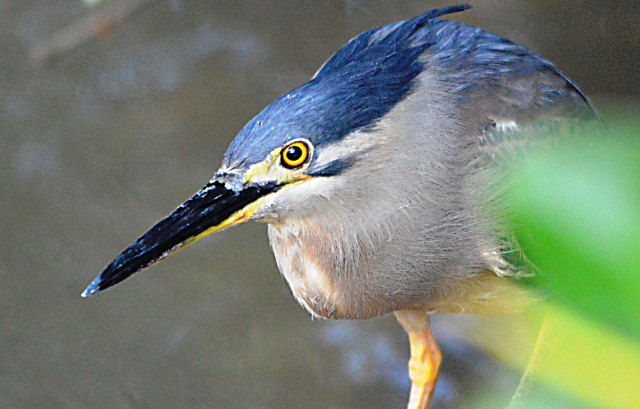Wetlands – management, habitat creation, restoration and enhancement.
Wetlands can have various functions, such as conservation/wildlife habitat and bird watching, typical in Western countries, or their primary function could be to produce food for people. Wetlands can of course be created, restored and managed to be multi-functional. The plants grown, and the management of the wetland, will depend on the goals and priorities.
Well designed and managed wetlands that are in or close to population centres are likely to be used intensively for rest and respite by painters, photographers, bird watchers, families feeding ducks, or by people who simply want to sit beside still waters and restore their souls.
*

Wetlands and wildlife
Wetlands are home to all sorts of wildlife and can be designed and managed to provide a haven for wildlife. A more unusual example of this occurred on July 25 2016, when I was taking photos of birds at the lake at Half Moon Bay Golf club (Yorkeys, Cairns, Australia). While I was on the bank of the lake a 1.5 metre crocodile stalked me, and swam over to about 3-4 metres from me to investigate. At this size, the crocodile was unlikely to attack an adult, but it was unnerving nevertheless. It may have been a different story for a small dog or child. The photos are in sequence:
*

*
*
*
Wildlife continued:
For wildlife habitat, there should be dense vegetation on the water edges, as well as away from the water line, with some open areas, and preferably the whole catchment area should be well vegetated. Also, “corridors” should be reforested between wetlands, connecting to rivers etc., if possible.
*
The water’s edge
One of the key principles is to have a densely vegetated edge of reeds or grasses, where fish and amphibians can breed and take shelter. Some birds also like to shelter and nest in a dense stand of reeds or long grasses. Some suitable plants (which should be selected from indigenous species, invasive weeds are often a big problem in wetlands) include tall reeds (or similar), such as Phragmites australis – one of the best, also good livestock fodder, Papyrus spp., Typha spp., Arundo donax, Pennisetum purpureum, Miscanthus. Some other shorter grasses and sedges which may be suitable include Papyrus spp., Baumea spp., Eleocharis spp., Juncus spp., Phalaris spp., Schoenoplectus spp., Paspalum spp., Brachiara spp., Hymenachne spp. Also, herbaceous species such as Rorippa spp., Persicaria spp., Hydrocotyle spp., Ludwigia spp., Myriophyllum spp., Monochoria cyanea etc.
Phragmites australis reeds, found in many parts of the world, forming a thicket, growing with Melaleuca quinquenervia. Cairns, Australia.

*

Small wetland west of Cairns cemetery. Litoria infrafrenata. Photo: David Clode.
*
*

In colder climates, hawthorn can provide dense, thorny wildlife habitat around a wetland, as well as providing nectar and fruit for wildlife.

*
Freshwater Lake, Cairns.
*
This farm dam with no vegetation on the water’s edge provides no habitat, places to breed or hide for wildlife. Farm dams are mainly about storing water, and some water would be lost from transpiring vegetation growing on the water’s edge. Atherton Tablelends, North Queensland.
The only thing missing here is floating duckweed, Azolla or similar. Cattana Wetlands, Cairns, North Queensland, Australia.
The edge should also include areas with overhanging vegetation, where nectar-filled flowers attract insects, providing food for birds and fish, eg. Melaleuca spp., Leptospermum spp, Alphitonia spp., Premna serratifolia, Crataegus spp., Pyracantha spp., Kunzea ambigua, Grevillea spp., Rubus spp.

*

Premna serratifolia attracting butterflies and bees. In North Queensland, this is one of the best plants for attracting a very wide variety of insects, with fruit attracting birds later.
*
*
An Archer fish. These fish have mouths which are designed to squirt water – they can knock insects off overhanging vegetation and down on to the water, then catch them and eat them.
Overhanging vegetation could include trees that drop fruit for fruit-eating fish, tadpoles and other wildlife, eg. figs (Ficus spp.), Nauclea orientalis, Acmena, Syzigium, Morus spp., Rubus spp.
Leea indica, the Bandicoot berry, produces flowers full of nectar which attract insects and birds, followed by fruit which is sought after by many species of wildlife. See also, “Multi-purpose plants” on the “Reforestation projects/techniques page” and living fences at the “Forest Fire Shields, No-fines concrete, Living Fences” page (click on the buttons at the top of this page).
Open areas
For waterbirds such as geese and ducks, an area of short grass will allow them to fly in to and out of an area where they can see there are no predators, and the short grass is also likely to be grazed by the birds. Reptiles like open sunny areas for basking.

*
The surface of the water
A wetland should ideally include surface floating plants such as duckweeds (eg. Lemna spp., Spirodella spp., Wolffia spp.) and Azolla spp. These provide food for many types of aquatic birds and herbivorous fish, tadpoles etc.

Nitrogen-fixing Azolla pinnata – see also the page Epiphytes, climate change, Azolla
Floating surface leaves and flowers are also important, such as water lilies eg. Nymphaea spp., Nymphoides indica and lotus lilies (Nelumbo nucifera).
*

*

*
*
Small Australian native bee visiting a Lotus lily.
*

*
*
*
*
*
A Little Pied Cormorant fishing beneath water lily leaves.
Beneath the water
Submerged aquatic plants are important habitat and food sources for fish, crustaceans and amphibians e.g. Valisneria spp., Egeria spp., Hydrilla spp., Ceratophyllum demersum, Elodea spp.
Habitat creation/enhancement
Dense thorny thickets provide refuges for wildlife, see photos further up this page.
Islands are a useful addition, providing relatively safe refuges for birds and other wildlife. Islands could have a dead tree or large branches added for them to perch and roost.
Logs (preferably hollow), dead trees or large branches which lie at an angle from the bank into the water or out low across the water are likely to be used by reptiles such as fresh water tortoises (terrapins), lizards such as iguanas and Varanus spp., and snakes for basking. Some of these animals like to drop into the water and hide underwater if they see a predator approaching.

Heavy hollow logs underwater will provide a safe haven for eels and other fish, crustaceans etc. “Reefballs” could also perform this function – see http://www.reefball.com/. Reefballs could be placed so that just the top forms an island above the surface, and the rest of the submerged ball acts as a hollow log. The reefballs could be made of no-fines concrete to provide additional nooks and crannies for homes for smaller creatures. However, the usefulness of islands and hollow logs underwater is disputed by some experts (Romanowski 2010).
A grassy island, Cattana wetlands.
*
Perches. Trees provide perches for birds. Dead branches can also be used, placed upright with near horizontal branches for perches, and/or they can also be placed to spread out horizontally over the water. To place a dead branch, a durable wooden stake can be hammered into the ground, and the branch attached with at least three lengths of wire around the branch and stake, and the ends of the wire twisted together with pliers.

*

*

*
*

*
*

Regarding the shape of wetlands and islands, see the “edge effect” on the Reforestation projects/techniques page, as well as the “oasis effect”, and “thorny thickets”.
Human use
If the primary function of a wetland is for food, then some suitable plants could include Water chestnuts (Eleocharis dulcis), Rorippa spp., Nelumbo nucifera, Aponogeton distachyos, rice, taro etc.. Azolla provides food for livestock and herbivorous fish such as grass carp.
Fish might include tilapia (a pest in some countries), grass carp, Barramundi, golden perch, Arapaima, trout, crustaceans etc. Fish are some of the most efficient converters of plant material into animal protein. For herbivorous fish such as grass carp, the edge could be planted with a complementary mix of a fast-growing grass such as Pennisetum purpureum, Andropogon gayanus, or Phalaris spp., for bulk feed, combined with a nitrogen-fixing tree or shrub such as Sesbania grandiflora, Falcataria moluccana, or Leucaena leucocephala for high protein feed. These plants grow fast and can be repeatedly cut, providing a large amount of feed, and hence a large amount of animal protein.
Food production can also be increased indirectly by using water plants (especially invasive weed species), to make compost or biochar. Wetland plants such as water hyacinth and papyrus can be harvested to produce fuel (dried, and made into briquettes, improving fuel security) for fuel-efficient stoves to make biochar. See for example, the outstanding work by the African Christians Organisation Network in Kenya, http://aconetwork.weebly.com , contact Salim Shaban at salimshaban2005@gmail.com.
In developed countries, the primary purpose of wetlands for people may be for bird watching, and hides are often built for this purpose – see Scott (1980), below, for some tips on hide construction.
Pelican, Freshwater lake, Centenary lakes, Cairns, North Queensland, Australia.

*
*
*
*
Boronia wetland, Melbourne, Victoria, Australia
This area is designed to capture and store runoff so that less water enters the storm water darinage system during intense rain fall. After a few years, the planting has established well, and the wildlife is moving in.
*
*
*
*
***
Some references/resources:
Finlayson, M., and Moser, M. 1991. Wetlands. Facts On File Limited. ISBN 0-8160-2556-8.
Romanowski, Nick. 2010. Wetland habitats: a practical guide to restoration and management. CSIRO PUBLISHING. ISBN 9780643096462.
Romanowski, Nick. 1998. Aquatic and wetland plants: a field guide for non-tropical Australia. UNSW Press. ISBN 0 86840 632 5
Romanowski, Nick. 2005. Planting wetlands and dams: a practical guide to wetland design, construction and propagation. UNSW Press. ISBN 086840 608 2
Scott, Sir Peter. 1980. Observations of Wildlife. Phaidon Press Ltd. ISBN 0-7148-2041-5.
Stevens, K. M. 2002. Wetland plants of Queensland. CSIRO. ISBN 0 643 06674 8
*
*
*
*
*
*
*
*
***
Reforestation.me

























































Lovely website! I am loving it!! Will be back later to read some more. I am bookmarking your feeds also
LikeLike
Thank you Ty.
David.
LikeLike